|
Places to visit | Background information | Find a book about it |
|
|
The
Dover Patrol |
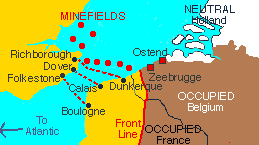 German bases at Zeebrugge and Ostend threatened the Allied supply lines across the Channel. A secret extra port was created at Richborough near Sandwich. |
World War 1: supplying
the Front German capture of the Belgian coast posed a threat to the safe passage of Allied shipping in the Channel. The Dover patrol was formed as a joint Anglo-French venture to protect the vital supply lines from Britain to the Front - while Allied leaders regretted they had not permitted the Channel Tunnel to be built.. |
|
The threat of mines |
|
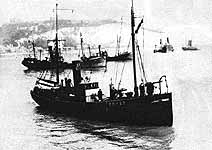 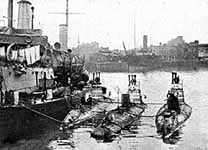 Dover Harbour: fishing boats were requisitioned to trawl for mines the Germans had dropped out in the Channel - The Dover patrol also had naval destroyers and small submarines (seen in Dover harbour) |
|
|
The Dover Patrol had bases in Dunkerque and Dover. They laid minefields as a first line of protection against the German Navy. Small German boats often succeeded in sneaking through to lay mines in the Channel.; the Patrol had to work ceaselessly to find these and remove them, using converted fishing trawlers. Local fishermen risked their lives to man the patrol boats. More than 2,000 died during the First World war. The Dover Patrol was under the command of Admiral Bacon, who was replaced in 1917 by Admiral Keyes. |
|
|
Crossing the Channel in wartime |
|
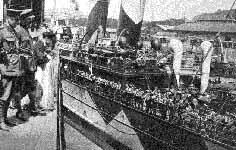  Troopship departing from Dover Harbour - Airship guarding a convoy crossing the Channel: it could spot German submarines or patrol boats. |
|
|
The Dover Patrol escorted merchant ships with supplies and munitions across the Channel, along with hospital ships carrying the wounded "back to Blighty" and troop ships with relacements for the Front. The Patrol also bombarded enemy positions on the Belgian coast. |
|
|
Submarine warfare |
|
  German U-boat offensive: German U-boat attacked on merchant ships crossing the Atlantic and coming up the Channel brought Britain near to starvation until the convoy system was properly organised. (left) U-boat stops an unarmed Allied merchant ship on the surface, saving its torpedoes for another target. (right) civilians were urged to save on imported wheat. |
|
|
Capturing the Belgian coast in 1914 gave the Germans an ideally situated base for their submarine war against Britain. They built a heavily fortified U-boat base on the Bruges Canal, which was linked to the sea at Ostend and Zeebrugge. Setting out down the Channel from Belgium cut 300 miles off the journey to the Atlantic, compared with going round Scotland from the North coast of Germany. By 1917 they were sinking 400 Allied ships a month, leading to the rationing of food supplies in Britain. The British government feared that Britain could soon be starved out of the War. The Dover Patrol had a vital role in preventing U-boats taking this short-cut through the Channel to the Atlantic. A giant net was strung across the Channel hung from buoys and fishing boats, with minefields on either side. The British Navy were convinced this barrage made it impossible for German submarines to pass through the Straits of Dover. But a German sub captured in early 1917 revealed documents that showed U-boats WERE still secretly sneaking through. They did so at night, sailing quietly on the surface, and passing over the top of the net barrage and the minefields. Night-time patrols, then forced U-boats to take the much longer route to the Atlantic via Scotland. This increased the "safe area" in the western Atlantic where merchant ships were out of range of the U-boats. |
|
|
April 1918: Zeebrugge
Raid The Belgians had opened Zeebrugge's huge artificial harbour in 1908, along with an eight mile long canal connecting Bruges with the North Sea, and another smaller canal to Ostend. The German U-boat base was on the canal, inside the lock gates that maintained the canal's water level at low tide. The canal entrance was protected from North Sea storms by a harbour wall or Mole stretching one and half miles out into the sea. The raid aimed to block the canal by sinking ships in the entrance. Unfortunately there were heavy losses when they attacked the heavily-defended Mole. The raid was was judged a success, because it stopped the Belgian bases being used for the remainder of the war, and trapped a large number of German submarines and warships up the canal - helping to end the menace of the German submarine offensive. |
|
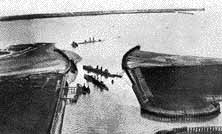 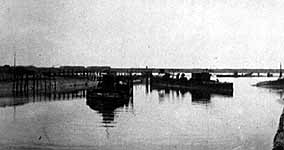 Zebrugge harbour: aerial view after the raid in April 1918 (left), with ships sunk by the Allies to block German subs in their base in the canal. Close up of wrecks (right). |
|
|
Memorials |
|
|
World War 2: protecting Channel convoys |
|
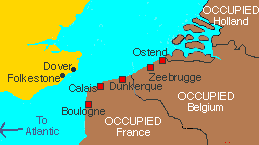 In 1940 all the coastline facing South East England was enemy occupied. |
A different situation was faced in the 1939-45 war. In 1915, France was largely unoccupied and kept fighting; but in 1940, Nazi Germany occupied all of northern France, and France and Holland had surrendered. Britain's links with America and other unoccied countries were through ports on the west coast facing the Atlantic - Liverpool, Glasgow, Bristol. But London was the biggest port, so convoys needed to be moved safely up the Channel from the Atlantic. |
|
Coastal shipping was important for moving supplies around Britain; and naval ships needed to be moved to and from the south coast. |
|
 The Dover Patrol 1914-18 - fully illustrated, by Roy Humphries Find out more at AMAZON |
||
|
Places to
visit: |
||
|
Nature parks: |
||
|
Related background
information |
|
|
|
|
|
